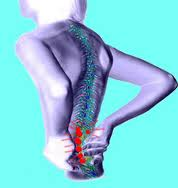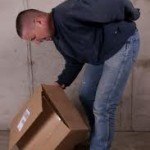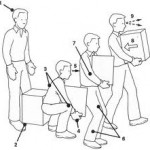Calculating injury-free lifting capabilities
One equation, known as the NIOSH lifting equation, provides a method for determining two weight limits associated with two levels of back injury risk. The first limit is called an action limit (AL), which represents a weight limit above which a small portion of the population may experience increased risk of injury if they are not trained to perform the lifting task. The second limit, called the maximum permissible limit (MPL) is calculated as three times the action limit. This weight limit represents a lifting condition at which most people would experience a high risk of back injury.
 The recommended weight limit (RWL) is the load value for a specific lifting task that nearly all healthy workers could perform for a substantial period of time without an increased risk of developing lifting-related low-back pain and is calculated as follows.
The recommended weight limit (RWL) is the load value for a specific lifting task that nearly all healthy workers could perform for a substantial period of time without an increased risk of developing lifting-related low-back pain and is calculated as follows.
RWL = LC × HM × VM × DM × AM × FM × CM
where
LC – load constant. Defines the maximum recommended weight for lifting under optimal conditions, such as symmetrical lifting position with no torso twisting, occasional lifting, good coupling, < 25 cm vertical distance of lifting.
HM – horizontal multiplier. Reflects the fact that disc compression force increases as the horizontal distance between the load and the spine increases. As a result, the maximum acceptable weight limit should be decreased from LC as the horizontal distance increases.
VM – vertical multiplier. The NIOSH lifting equation assumes that the best originating height of the load is 30 inches (or 75 cm) above the floor. Lifting from near the floor (too low) or high above the floor (too high) is more stressful that lifting from 30 inches above the floor. DM – distance multiplier; based on the suggestion that as the vertical distance of lifting increases, physical stress increases
 AM – asymmetric multiplier; torso twisting is more harmful to the spine than symmetric lifting. Therefore, the allowable weight of lift should be reduced when lifting tasks involve asymmetric body twists. CM – coupling multiplier, whose value depends on whether the load has good or bad coupling. If the loads have appropriate handles or couplings to help grab and lift the loads, it is regarded as good coupling. If the loads do not have easy-to-grab handles or couplings, but are not hard to grab and lift, it is fair coupling. Poor coupling is where the loads are hard to grab and lift. FM – frequency multiplier, is used to reflect the effects of lifting frequency on acceptable lift weights. H – horizontal distance between the hands lifting the load and the midpoint between the ankles.
AM – asymmetric multiplier; torso twisting is more harmful to the spine than symmetric lifting. Therefore, the allowable weight of lift should be reduced when lifting tasks involve asymmetric body twists. CM – coupling multiplier, whose value depends on whether the load has good or bad coupling. If the loads have appropriate handles or couplings to help grab and lift the loads, it is regarded as good coupling. If the loads do not have easy-to-grab handles or couplings, but are not hard to grab and lift, it is fair coupling. Poor coupling is where the loads are hard to grab and lift. FM – frequency multiplier, is used to reflect the effects of lifting frequency on acceptable lift weights. H – horizontal distance between the hands lifting the load and the midpoint between the ankles.
V – vertical distance of the hands from the floor. D – vertical travel distance between the origin and the destination of the lift. A – angle of symmetry (measured in degrees), which is the angle of torso twisting involved in lifting a load that is not directly in front of the person. F – average frequency of lifting measured in lifts/min
To quantify the degree to which a lifting task approaches or exceeds the RWL, a lifting index (LI) was proposed. LI is the ratio of the load lifted to the RWL, and is used to estimate the risk of specific lifting tasks in developing low-back disorders and to compare the lifting demands associate with different lifting tasks for the purpose of evaluating and redesigning them.
Lifting tasks with:
LI > 1 – likely to pose an increased risk for some workers
LI > 3 – many or most workers are at high risk of developing low-back pain and injury.
Material handling
Administrative precautions
- Strength testing of existing workers, which one study showed can prevent up to one-third of work-related injuries by discouraging the assignment of workers to jobs that exceed their strength capabilities.
- Training employees to utilize lifting techniques that place minimum stress on the lower back.
- Enhancing availability of material handling equipment such as carts, dollies or hand trucks.
- Physical conditioning or stretching programs to reduce the risk of muscle strain.
 Design parameters
Design parameters
- Loads should be kept close to the body and located at about tight or waist height if possible.
- Large  packages should not be presented to a worker at a height lower than about  mid-thigh, or about 30 in. above the floor (Chaffin, 1997). An adjustable lift table can be used to assist workers when handling large or heavy objects.
- Minimize torso twisting in materials handling
- Frequency of lifting should be minimized by adopting adequate lifting and workrest schedules.
- A  reduction in the size or weight of the object lifted. The parameters include maximum allowable weights for a given set of task requirements; the compactness of a package; the presence of handles, and the stability of the package being handled.
- Adjusting the height of a pallet or shelf. Lifting which occurs below knee height or above shoulder height is more strenuous than lifting between these limits. Obstructions which prevent an employee’s body contact with the object  being lifted also generally increase the risk of injury.
- Installation of mechanical aids such as pneumatic lifts, conveyors, and/or automated materials handling equipment.
Other factors such as whole body vibration, psychosocial factors, age, sex, body size, health, physical fitness, and nutrition conditions of a person, are also important in determining the incidence rate and severity of low back-pain.
In a recent study it was determined that up to one-third of compensated back injuries could be prevented through better job design (ergonomics).